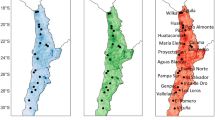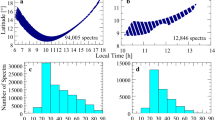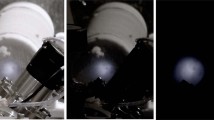Abstract
The terahertz and far-infrared band, ranging from approximately 0.3 THz to 15 THz (1 mm to 20 μm), is important for astrophysics as it hosts the peak of the thermal radiation of the cold component of the Universe as well as many spectral lines that trace the cycle of interstellar matter1–8. However, water vapour makes the terrestrial atmosphere opaque to this frequency band over nearly all of the Earth’s surface9. Early radiometric measurements10 below 1 THz at Dome A (80° 22′ S, 77° 21′ E), the highest point of the cold and dry Antarctic ice sheet, suggest that this site may offer the best possible access for ground-based astronomical observations in the terahertz and far-infrared band. To fully assess the site conditions and to address the uncertainties in radiative transfer modelling of the atmosphere, we carried out measurements of atmospheric radiation from Dome A with a Fourier transform spectrometer, spanning the entire water vapour pure rotation band from 20 μm to 350 μm. Our measurements reveal substantial transmission in atmospheric windows throughout the whole band. By combining our broadband spectra with data on the atmospheric state over Dome A, we set new constraints on the spectral absorption of water vapour at upper tropospheric temperatures, which is important for accurate modelling of the terrestrial climate. We find that current spectral models significantly underestimate the H2O continuum absorption.
This is a preview of subscription content, access via your institution
Access options
Subscribe to this journal
Receive 12 digital issues and online access to articles
$119.00 per year
only $9.92 per issue
Buy this article
- Purchase on Springer Link
- Instant access to full article PDF
Prices may be subject to local taxes which are calculated during checkout



Similar content being viewed by others
References
Phillips, T. G. & Keene J. Submillimeter astronomy. Proc. IEEE 80, 1662–1678 (1992).
Watson, D. M. Far-infrared spectroscopy and the physics and chemistry of interstellar clouds. Phys. Scripta T11, 33–47 (1985).
Goldsmith, P. F., Yildiz, U. A., Langer, W. D. & Pineda, J. L. Herschel galactic plane survey of [N ii] fine structure emission. Astrophys. J. 814, 133 (2015).
Goicoechea, J. R. et al. Velocity-resolved [C ii] emission and [C ii]/FIR mapping along Orion with Herschel. Astrophys. J. 812, 75 (2015).
Wiedner, M. C. et al. First observations with CONDOR, a 1.5 THz heterodyne receiver. Astron. Astrophys. 454, L33–L36 (2006).
Hogerheijde, M. R. et al. Probable detection of H2D+ in the starless core Barnard 68. Astron. Astrophys. 454, L59–L62 (2006).
Caselli, P. et al. Survey of ortho-H2D+ (11,0 – 11,1) in dense cloud cores. Astron. Astrophys. 492, 703–718 (2008).
Rolffs, R. et al. Reversal of infall in SgrB2(M) revealed by Herschel/HIFI observations of HCN lines at THz frequencies. Astron. Astrophys. 521, L46 (2010).
Harries, J. et al. The far-infrared Earth. Rev. Geophys. 46, RG4004 (2008).
Yang, H. et al. Exceptional terahertz transparency and stability above Dome A, Antarctica. Publ. Astron. Soc. Pacif. 122, 490–494 (2010).
J. Qiu China aims high from the bottom of the world. Nature News (29 August 2012); http://go.nature.com/2fQfBkN.
Li, X.-X. et al. A Fourier transform spectrometer for site testing at Dome A. Proc. SPIE 7385, 73851D (2009).
Matsushita, S., Matsuo, H., Pardo, J. R. & Radford S. J. E. FTS measurements of submillimeter-wave atmospheric opacity at Pampa la Bola II: supra-terahertz windows and model fitting. Publ. Astron. Soc. Jpn 51, 603–610 (1999).
Marrone, D. P. et al. Observations in the 1.3 and 1.5 THz atmospheric windows with the Receiver Lab Telescope. In Proc. 16th Int. Symp. Space Terahertz Technology (ed Ingvarson, M.) 64–67 (International Symposium on Space Terahertz Technology, 2005).
Shine, K. P., Ptashnik, I. V. & Rädel, G. The water vapor continuum: brief history and recent developments. Surv. Geophys. 33, 535–555 (2012).
Mlawer, E. J. et al. Development and recent evaluation of the MT_CKD model of continuum absorption. Phil. Trans. R. Soc. A 370, 2520–2556 (2012).
Ramanathan, V. & Coakley, J. A. Climate modelling through radiative-convective models. Rev. Geophys. Space Phys. 16, 465–489 (1978).
Clough, S. A., Iacono, M. & Moncet, J.-L. Line-by-line calculations of atmospheric fluxes and cooling rates: application to water vapor. J. Geophys. Res. 97, 15761–15785 (1992).
Turner, D. D., Merrelli, A., Vimont, D. & Mlawer, E. J. Impact of modifying the longwave water vapor continuum absorption model on community Earth system model simulations. J. Geophys. Res. 117, D04106 (2012).
Paynter, D. J. & Ramaswamy, V. An assessment of recent water vapour continuum measurements upon longwave and shortwave radiative transfer. J. Geophys. Res. 116, D20302 (2011).
Turner, D. D. & Mlawer, E. J. The radiative heating in underexplored bands campaigns. Bull. Am. Meteorol. Soc. 91, 911–923 (2010).
Delamere, J. S. et al. A far-infrared radiative closure study in the Arctic: application to water vapour. J. Geophys. Res. 115, D17106 (2010).
Turner, D. D. et al. Ground-based high spectral resolution observations of the entire terrestrial spectrum under extremely dry conditions. Geophys. Res. Lett. 39, L10801 (2012).
Bhawar, R. et al. Spectrally resolved observations of atmospheric emitted radiance in the H2O rotation band. Geophys. Res. Lett. 35, L04812 (2008).
Serio, C. et al. Retrieval of foreign-broadened water vapor continuum coefficients from emitted spectral radiance in the H2O rotational band from 240 to 590 cm−1 . Opt. Express 16, 15816–15833 (2008).
Green, P. D. et al. Recent advances in measurement of the water vapour continuum in the far-infrared spectral region. Phil. Trans. R. Soc. A 370, 2637–2655 (2012).
Rienecker, M. M. et al. MERRA: NASA’s modern-era retrospective analysis for research and applications. J. Clim. 24, 3624–3648 (2011).
Wang, J. et al. Unprecedented upper-air dropsonde observations over Antarctica from the 2010 Concordiasi experiment: validation of satellite-retrieved temperature profiles. Geophys. Res. Lett. 40, 1231–1236 (2013).
Hudson, S. R. & Brandt, R. E. A Look at the surface-based temperature inversion on the Antarctic plateau. J. Clim. 18, 1673–1696 (2005).
Paine, S. The am atmospheric model v. 9.0 Submillimeter Array Technical Memo No. 152 (Smithsonian Astrophysical Observatory, 2016); http://doi.org/10.5281/zenodo.61127
Martin D. H. & Puplett, E. Polarised interferometric spectrometry for the millimetre and submillimetre spectrum. Infrared Phys. 10, 105–109 (1969).
Lawrence, J. S. et al. The PLATO Dome A site-testing observatory: power generation and control systems. Rev. Sci. Instrum. 80, 064501 (2009).
Revercomb, H. E. et al. Radiometric calibration of IR Fourier transform spectrometers: solution to a problem with the high-resolution interferometer sounder. Appl. Optics 27, 3210–3218 (1988).
Fleming, J. W. et al. Temperature effects and the observation of the B2u lattice mode in the far infrared absorption spectrum of polyethylene. Chem. Phys. Lett. 17, 84–85 (1972).
Amrhein, E. M. & Heil, H. Dielectric absorption of polymers from the millimetre to the far infrared region. J. Phys. Chem. Solids 32, 1925–1933 (1971).
Chantry, G. W. et al. Far infrared and millimetre-wave absorption spectra of some low-loss polymers. Chem. Phys. Lett. 10, 473–477 (1971).
Acknowledgements
We acknowledge the assistance of the 26th and 27th CHINARE teams supported by the Polar Research Institute of China and the Chinese Arctic and Antarctic Administration, the University of New South Wales PLATO team, the CAS Center for Antarctic Astronomy team and the other teams contributing to the operation of the Dome A facilities, in particular J.W.V. Storey, D.M. Luong-Van, A. Moore, C. Pennypacker, D. York, L. Wang, L. Feng, Z. Zhu, H. Yang, X. Cui, X. Yuan, X. Gong, X. Zhou, X. Liu, Z. Wang, and J. Huang. The exemplary work of D. Naylor and B. Gom of Blue Sky Spectroscopy Inc. and K. Wood of QMC Instruments Inc. is acknowledged. We also acknowledge discussions with D.D. Turner of NOAA on complex-domain calibration of the FTS spectra, and E.J. Mlawer of AER Inc. on the MT_CKD water vapour continuum model and its implementation in the radiative transfer code used in this work. MERRA data used in this study were provided by the Global Modeling and Assimilation Office (GMAO) at NASA Goddard Space Flight Center through the NASA GES DISC online archive. Primary support for this research was provided by the Operation, Maintenance and Upgrading Fund for Astronomical Telescopes and Facility Instruments, funded by the Ministry of Finance of China (MOF) and administered by the CAS. The traverse team was financially supported by the Chinese Polar Environment Comprehensive Investigation & Assessment Program. The PLATO team was funded by the Australian Research Council and the Australian Antarctic Division. Iridium satellite communications were provided by the US National Science Foundation and the US Antarctic Program. Co-authors S.P. and Q.Z. received additional support for this work from Smithsonian Institution Endowment funds and the Smithsonian Competitive Grants Program for Science. Co-author H.M. was supported partly by a visiting professorship of CAS for senior international scientists.
Author information
Authors and Affiliations
Contributions
S.-C.S., S.P., Q.Z. and J.Y. proposed the Dome A FTS project, with S.-C.S. as the principal investigator. All authors contributed substantially to multiple aspects of the work presented here. All authors commented upon and approved the final manuscript.
Corresponding author
Ethics declarations
Competing interests
The authors declare no competing financial interests.
Supplementary information
Supplementary Information
Supplementary Figures 1–7 (PDF 1349 kb)
Rights and permissions
About this article
Cite this article
Shi, SC., Paine, S., Yao, QJ. et al. Terahertz and far-infrared windows opened at Dome A in Antarctica. Nat Astron 1, 0001 (2017). https://doi.org/10.1038/s41550-016-0001
Received:
Accepted:
Published:
DOI: https://doi.org/10.1038/s41550-016-0001
This article is cited by
-
Terahertz atmospheric transmission measured at the AliCPT site
Science China Physics, Mechanics & Astronomy (2023)
-
Socioeconomic roots of academic faculty
Nature Human Behaviour (2022)
-
Influence of the first-mover advantage on the gender disparities in physics citations
Communications Physics (2022)
-
Narrative thinking lingers in spontaneous thought
Nature Communications (2022)
-
Receptor-informed network control theory links LSD and psilocybin to a flattening of the brain’s control energy landscape
Nature Communications (2022)



